The Bulldozer Review: AMD FX-8150 Tested
by Anand Lal Shimpi on October 12, 2011 1:27 AM ESTThe Test
To keep the review length manageable we're presenting a subset of our results here. For all benchmark results and even more comparisons be sure to use our performance comparison tool: Bench.
| Motherboard: |
ASUS P8Z68-V Pro (Intel Z68) ASUS Crosshair V Formula (AMD 990FX) |
| Hard Disk: |
Intel X25-M SSD (80GB) Crucial RealSSD C300 |
| Memory: | 2 x 4GB G.Skill Ripjaws X DDR3-1600 9-9-9-20 |
| Video Card: | ATI Radeon HD 5870 (Windows 7) |
| Video Drivers: | AMD Catalyst 11.10 Beta (Windows 7) |
| Desktop Resolution: | 1920 x 1200 |
| OS: | Windows 7 x64 |
Windows 7 Application Performance
3dsmax 9
Today's desktop processors are more than fast enough to do professional level 3D rendering at home. To look at performance under 3dsmax we ran the SPECapc 3dsmax 8 benchmark (only the CPU rendering tests) under 3dsmax 9 SP1. The results reported are the rendering composite scores.

As our first heavily threaded, predominantly FP workload we see the FX-8150 come out swinging. A tangible upgrade from the Phenom II X6, the 8150 is hot on the heelds of the Core i5 2400, however it is unable to compete with the 2500K and 2600K.
Cinebench R10 & 11.5
Created by the Cinema 4D folks we have Cinebench, a popular 3D rendering benchmark that gives us both single and multi-threaded 3D rendering results.
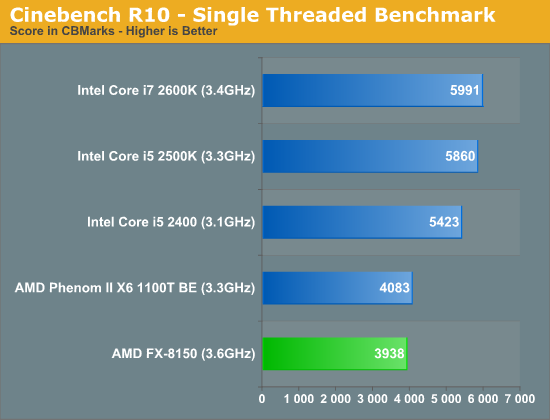
As I alluded to earlier, single threaded performance is going to be a bit of a disappointment with Bulldozer and here you get the first dose of reality. Even considering its clock speed and Turbo Core advantage, the FX-8150 is slower than the Phenom II X6 1100T. Intel's Core i5 2500K delivers nearly 50% better single threaded performance here than the FX-8150.
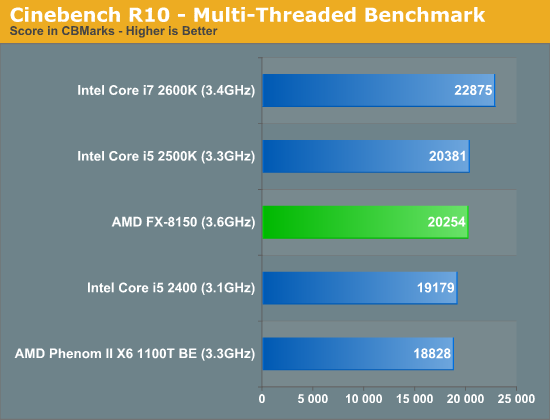
Crank up the threads and the FX-8150 shines, finally tying the 2500K at a comparable price point.
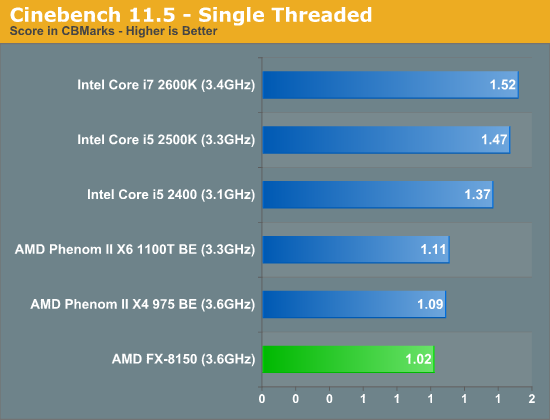
Even with more modern workloads, the FX-8150 isn't able to compete in single threaded speed. Here the 2500K is 44% faster.
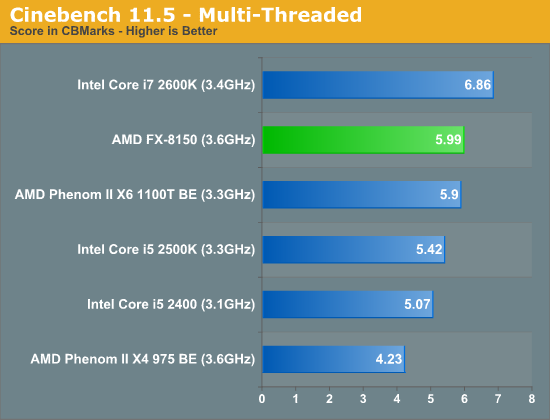
Modern multithreaded workloads however do quite well on Bulldozer. The gains over the old Phenom II X6 1100T are unfortunately not as large as we would expect them to be.
7-Zip Benchmark
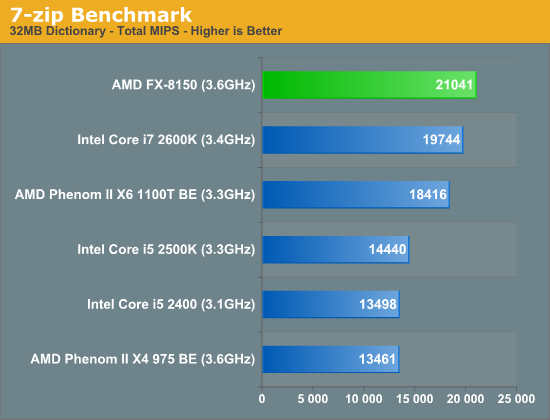
Heavily threaded workloads obviously do well on the FX series parts, here in our 7-zip test the FX-8150 is actually faster than Intel's fastest Sandy Bridge.
PAR2 Benchmark
Par2 is an application used for reconstructing downloaded archives. It can generate parity data from a given archive and later use it to recover the archive
Chuchusoft took the source code of par2cmdline 0.4 and parallelized it using Intel’s Threading Building Blocks 2.1. The result is a version of par2cmdline that can spawn multiple threads to repair par2 archives. For this test we took a 708MB archive, corrupted nearly 60MB of it, and used the multithreaded par2cmdline to recover it. The scores reported are the repair and recover time in seconds.
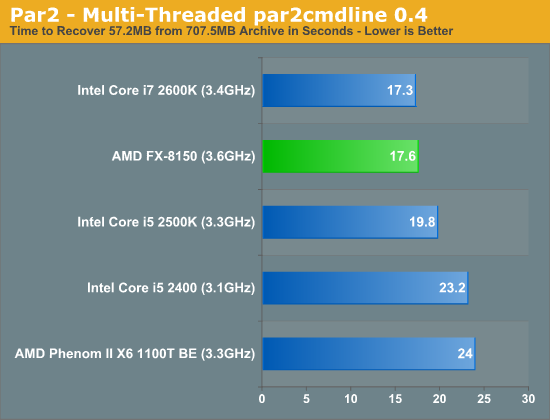
Once again, throw more threads at the processor and the FX-8150 can outperform the Core i5 2500K.
TrueCrypt Benchmark
TrueCrypt is a very popular encryption package that offers full AES-NI support. The application also features a built-in encryption benchmark that we can use to measure CPU performance with:
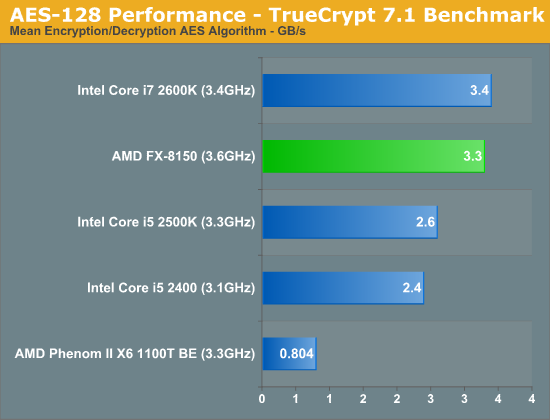
Bulldozer adds AES-NI acceleration, a feature that wasn't present in the Phenom II X6. As a result the FX-8150 is among the fastest at real time AES encryption/decryption, second only to the 2600K. Intel's artificial segmentation using Hyper Threading comes back to haunt it here as the 2500K is significantly slower than the 8-threaded beast.
x264 HD 3.03 Benchmark
Graysky's x264 HD test uses x264 to encode a 4Mbps 720p MPEG-2 source. The focus here is on quality rather than speed, thus the benchmark uses a 2-pass encode and reports the average frame rate in each pass.
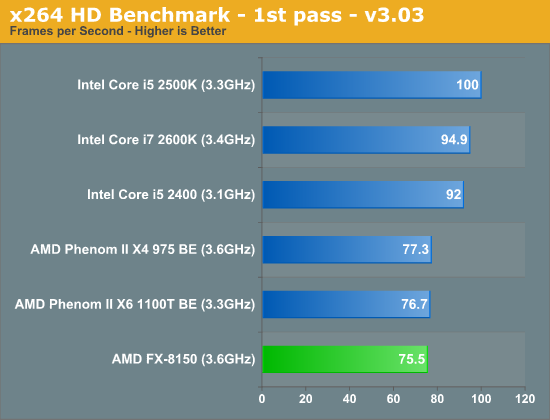
As I mentioned earlier, the first pass of our x264 HD benchmark is a lightly threaded task. As such, the FX-8150 doesn't do very well here. Even the old Phenom II is able to inch ahead of AMD's latest. And Sandy Bridge obviously does very well.

The second pass is more thread heavy, allowing the FX-8150 to flex its muscle and effectively tie the 2600K for first place.
AMD also sent along a couple of x264 binaries that were compiled with AVX and AMD XOP instruction flags. We ran both binaries through our x264 test, let's first look at what enabling AVX does to performance:
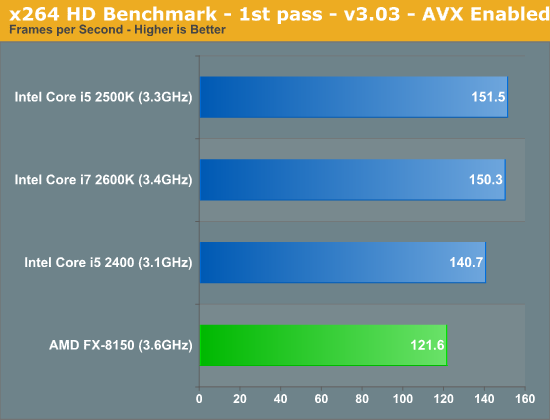
Everyone gets faster here, but Intel continues to hold onto a significant performance lead in lightly threaded workloads.
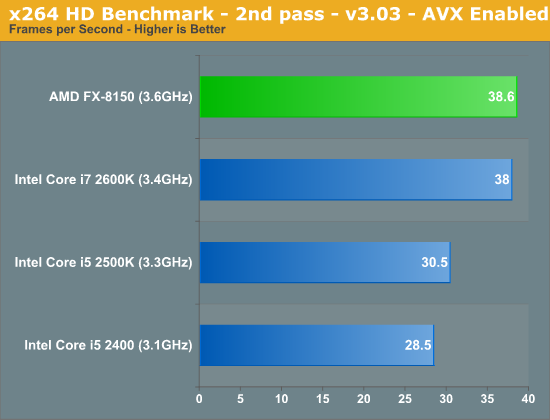
The standings don't change too much in the second pass, the frame rates are simply higher across the board. The FX-8150 is an x86 transcoding beast though, roughly equalling Intel's Core i7 2600K. Although not depicted here, the performance using the AMD XOP codepath was virtually identical to the AVX results.
Adobe Photoshop CS4
To measure performance under Photoshop CS4 we turn to the Retouch Artists’ Speed Test. The test does basic photo editing; there are a couple of color space conversions, many layer creations, color curve adjustment, image and canvas size adjustment, unsharp mask, and finally a gaussian blur performed on the entire image.
The whole process is timed and thanks to the use of Intel's X25-M SSD as our test bed hard drive, performance is far more predictable than back when we used to test on mechanical disks.
Time is reported in seconds and the lower numbers mean better performance. The test is multithreaded and can hit all four cores in a quad-core machine.
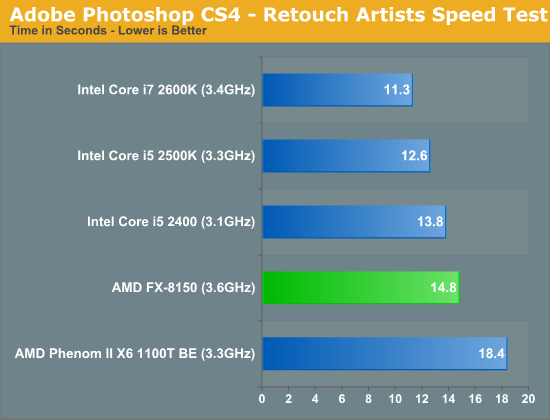
Photoshop performance improves tangibly over the Phenom II X6, unfortunately it's not enough to hang with the enthusiast Sandy Bridge parts.
Compile Chromium Test
You guys asked for it and finally I have something I feel is a good software build test. Using Visual Studio 2008 I'm compiling Chromium. It's a pretty huge project that takes over forty minutes to compile from the command line on a dual-core CPU. But the results are repeatable and the compile process will easily stress more than 8 threads on a CPU so it works for me.
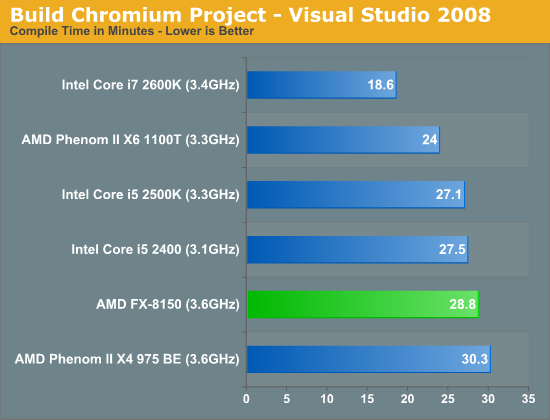
Our compiler test has traditionally favored heavily threaded architectures, but here we found the Phenom II X6 1100T to offer a tangible performance advantage over Bulldozer. While AMD is certainly competitive here, this is an example of one of those situations where AMD's architectural tradeoffs simply don't pay off—not without additional clock speed that is.
Excel Monte Carlo

Our final application test is another win for AMD over the Core i5 2500K. The victory is entirely a result of Intel's Hyper Threading restrictions though, the eight-thread 2600K is able to easily outperform Bulldozer. Either way, AMD delivers better performance here for less money.










430 Comments
View All Comments
THizzle7XU - Wednesday, October 12, 2011 - link
Well, why would you target the variable PC segment when you can program for a well established, large user-base platform with a single configuration and make a ton more money with probably far less QA work since there's only one set (two for multi-platform PS3 games) of hardware to test?And it's not like 360/PS3 games suddenly look like crap 5-6 years into their cycles. Think about how good PS2 games looked 7 years into that system's life cycle (God of War 2). Devs are just now getting the most of of the hardware. It's a great time to be playing games on 360/PS3 (and PC!).
GatorLord - Wednesday, October 12, 2011 - link
Consider what AMD is and what AMD isn't and where computing is headed and this chip is really beginning to make sense. While these benches seem frustrating to those of us on a desktop today I think a slightly deeper dive shows that there is a whole world of hope here...with these chips, not something later.I dug into the deal with Cray and Oak Ridge, and Cray is selling ORNL massively powerful computers (think petaflops) using Bulldozer CPUs controlling Nvidia Tesla GPUs which perform the bulk of the processing. The GPUs do vastly more and faster FPU calculations and the CPU is vastly better at dishing out the grunt work and processing the results for use by humans or software or other hardware. This is the future of High Performance Computing, today, but on a government scale. OK, so what? I'm a client user.
Here's what: AMD is actually best at making GPUs...no question. They have been in the GPGPU space as long as Nvidia...except the AMD engineers can collaborate on both CPU and GPU projects simultaneously without a bunch of awkward NDAs and antitrust BS getting in the way. That means that while they obviously can turn humble server chips into supercomputers by harnessing the many cores on a graphics card, how much more than we've seen is possible on our lowly desktops when this rebranded server chip enslaves the Ferraris on the PCI bus next door...the GPUs.
I get it...it makes perfect sense now. Don't waste real estate on FPU dies when the one's next door are hundreds or thousands of times better and faster too. This is not the beginning of the end of AMD, but the end of the beginning (to shamlessely quote Churchill). Now all that cryptic talk about a supercomputer in your tablet makes sense...think Llano with a so-so CPU and a big GPU on the same die with some code tweaks to schedule the GPU as a massive FPU and the picture starts taking shape.
Now imagine a full blown server chip (BD) harnessing full blown GPUs...Radeon 6XXX or 7XXX and we are talking about performance improvements in the orders of magnitude, not percentage points. Is AMD crazy? I'm thinking crazy like a fox.
Oh..as a disclaimer, while I'm long AMD...I'm just an enthusiast like the rest of you and not a shill...I want both companies to make fast chips that I can use to do Monte Carlos and linear regressions...it just looks like AMD seems to have figured out how to play the hand they're holding for change...here's to the future for us all.
Menoetios - Wednesday, October 12, 2011 - link
I think you bring up a very good point here. This chip looks like it's designed to be very closely paired with a highly programmable GPU, which is where the GPU roadmaps are leading over the next year and a half. While the apples-to-apples nature of this review draw a disappointing picture, I'm very curious how AMD's "Fusion" products next year will look, as the various compute elements of the CPU and GPU become more tightly integrated. Bulldozer appears to fit perfectly in an ecosystem that we don't quite have yet.GatorLord - Wednesday, October 12, 2011 - link
Exactly. Ecosystem...I like it. This is what it must feel like to pick up a flashlight at the entrance to the tunnel when all you're used to is clubs and torches. Until you find the switch, it just seems worse at either...then viola!actionjksn - Wednesday, October 12, 2011 - link
Wow I hope that made you feel better about the crappy chip also known a "Man With A Shovel"I was just hoping AMD would quit forcing Intel to have to keep on crippling their chips, just to keep them from putting AMD out of business. AMD better fix this abortion quick, this is getting old.
GatorLord - Thursday, October 13, 2011 - link
Feeling fine. Not as good in the short run, but feeling better about the long run. Unfortunately, due to constraints, it takes AMD too long to get stuff dialed in and by the time they do, Intel has already made an end run and beat them to the punch.Intel can do that, they're 40x as big as AMD. Actually, and this may sound crazy until you digest it, the smartest thing Intel could do is spin off a couple of really good dev labs as competitors. Relying on AMD to drive your competition is risky in that AMD may not be able to innovate fast enough to push Intel where it could be if they had more and better sharks in the water nipping at their tails.
You really need eight or more highly capable, highly aggressive competitors to create a fully functioning market free of monopolistic and oligopolistic sluggishness and BS hand signalling between them. This space is too capital intensive for that at the time being with the current chip making technology what it is.
yankeeDDL - Wednesday, October 12, 2011 - link
Just to be the devil's advocate ...The launch event in London sported 2 PC, side by side, running Cinebench.
One had the core i5-2500k, the other the FX8150.
Of course, these systems are prepared by AMD, so the results from Anand are clearly more reliable (at least all the conditions are documented).
Nevertheless, it is clear that in the demo from AMD, the FX runs faster. Not by a lot, but it is clearly faster than the i5.
Video: http://www.viddler.com/explore/engadget/videos/335...
Even so, assuming that this was a valid datapoint, things won't change too much: the i5-2500k is cheaper and (would be) slightly slower than the FX8150 in the most heavily threaded benchmark. But it would be slightly better than Anand's results show.
KamikaZeeFu - Wednesday, October 12, 2011 - link
"Nevertheless, it is clear that in the demo from AMD, the FX runs faster. Not by a lot, but it is clearly faster than the i5."Check the review, cinebench r11.5 multithreaded chart.
Anand's numbers mirror the ones by AMD. Multithreaded workloads are the only case where the 8150 will outperform an i5 2500k because it can process twice the amount of threads.
Really disappointed in AMD here, but I expected subpar performance because it was eerily quiet about the FX line as far as performance went.
Desktop BD is a full failure, they were aiming for high clock speeds and made sacrifices, but still failed their objective. By the time their process is mature and 4 GHz dozers hit the channel, Ivy bridge will be out.
As far as server performance goes, not even sure they will succeed there.
As seen in the review, clock for clock performance isn't up compared to the prvious generation, and in some cases it's actually slower. Considering that servers run at lower clocks in the first place, I don't see BD being any threat to intels server lineup.
4 years to develop this chip, and their motto seemed to be "we'll do netburst but in not-fail"
medi01 - Wednesday, October 12, 2011 - link
So CPU is a bottleneck in your games eh?TekDemon - Wednesday, October 12, 2011 - link
It's not but people don't buy CPUs for today's games, generally you want your system to be future proof so the more extra headroom there is in these CPU benchmarks the better it holds up over the long term. Look back at CPU benchmarks from 3-4 years ago and you'll see that the CPUs that barely passed muster back then easily bottleneck you whereas CPUs that had extra headroom are still usable for gaming. For example the Core 2 Duo E8400 or E8500 is still a very capable gaming CPU, especially when given a mild overclock and frankly in games that only use a few threads (like Starcraft 2) it gives Bulldozer a run for the money.I'm not a fanboy either way since I own that E8400 as well as a Phenom II (unlocked to X4, OC'ed to 3.9Ghz) and a i5 2500K but if I was building a new system I sure as heck would want extra headroom for future-proofing.
That said? Of course these chips will be more than enough power for general use. They're just not going to be good for high end systems. But in a general use situation the problem is that the power consumption is just crappy compared to the intel solutions, even if you can argue that it's more than enough power for most people why would you want to use more electricity?